Pests and diseases of honeysuckle: signs of damage and methods of dealing with them
Honeysuckle is a plant that can look completely different depending on the variety. Decorative varieties are liana and bloom in large beautiful inflorescences. Blueberry edible honeysuckle is not as aesthetic during flowering, but it produces tasty and healthy berries. Despite the differences, these species have similar growing requirements.
The most serious and common problem for all types of honeysuckle is pests. Because of them, the plant loses leaves, inflorescences and harvest. Without timely treatment, it stops developing and dies. Read about the diseases and pests of honeysuckle and methods of dealing with them below.
The content of the article
Pests of edible and decorative honeysuckle and methods of dealing with them
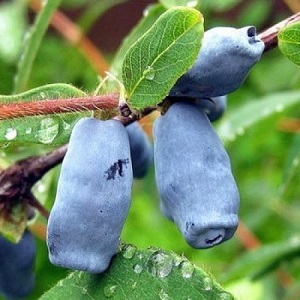
Honeysuckle Honeysuckle and the edible variety of this plant is equally susceptible to pest attacks.
Insects, mites and bugs feed on sap, leaves, shoots and berries. Because of this, yield decreases, the quality of berries deteriorates, leaves and inflorescences fall off, photosynthesis is disrupted, and the growth of new shoots stops. Some of the pests cause the death of the crop.
To prevent the appearance of harmful insects, gardeners spray the garden with insecticides in early spring. But a one-time treatment is not always effective, and for edible honeysuckle, the use of chemicals after the appearance of inflorescences is unacceptable.
What if the plant has already been affected by pests? To get rid of them, you need to correctly recognize the insect. Depending on this, a method of struggle is chosen.
Spider mite
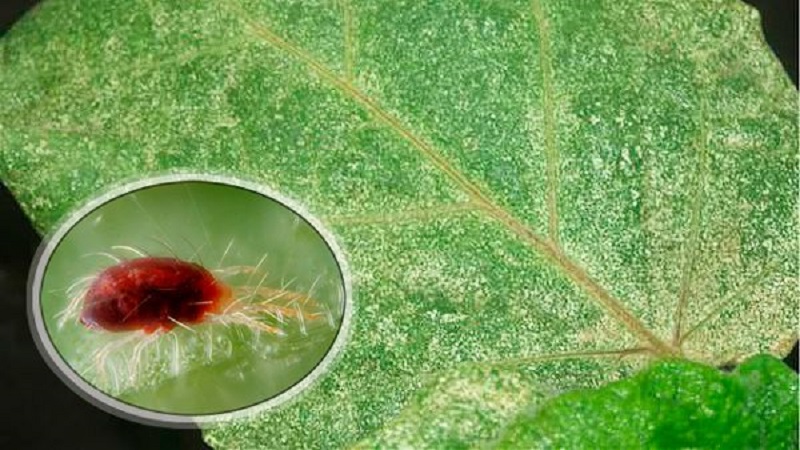
The spider mite is the most common pest of garden plants. It appears in dry weather and multiplies rapidly.
The honeysuckle mite feeds on juices from leaves and young shoots. This leads to leaf fall, reduced winter hardiness, loss of yield. Without timely treatment, sick honeysuckle simply will not survive the winter.
A spider mite is recognized by the following features:
- A cobweb appears on the underside of the leaves. The pest multiplies in it.
- If you look closely, small insects are visible in the affected areas. They come in black, red, brown, yellow, and green.
- Irregular spots appear on the leaves. Gradually they merge, and the leaf turns yellow. Premature leaf fall is observed.
Removing the tick is easy. It is recommended to tear off the affected leaves before treatment. If the presence of a mite is noticeable on most of the leaf plates, the pest is first washed off with warm water.
How to deal with spider mites on honeysuckle:
- Soap solution with tobacco. A piece of grated laundry soap is dissolved in a bucket of water at room temperature. 1 kg of tobacco is also added there. The mixture is infused for a day, then filtered and used to spray a sick bush or liana. The procedure is repeated every 5 days at least 3 times.
- Decoction of bitter herbs. To prepare the product, 0.5 kg of dandelion, wormwood, yarrow or celandine are poured into 2 liters of water. The herbs are boiled for half an hour and left to infuse for a day. The broth is filtered and diluted with 8 liters of water. Used to spray the affected plant.
- Insecticides.Such chemicals allow you to quickly get rid of the pest and protect against re-infection within 2 weeks. However, they are toxic to humans, animals and the environment. For edible crops, they are used only as a last resort. Such funds include "Rogor", "Actellik", etc.
In addition to bitter herbs, an infusion of onions and garlic, hot peppers or citrus peels is often used.
Note! Folk remedies are also used to prevent the appearance of a pest.
Caterpillars
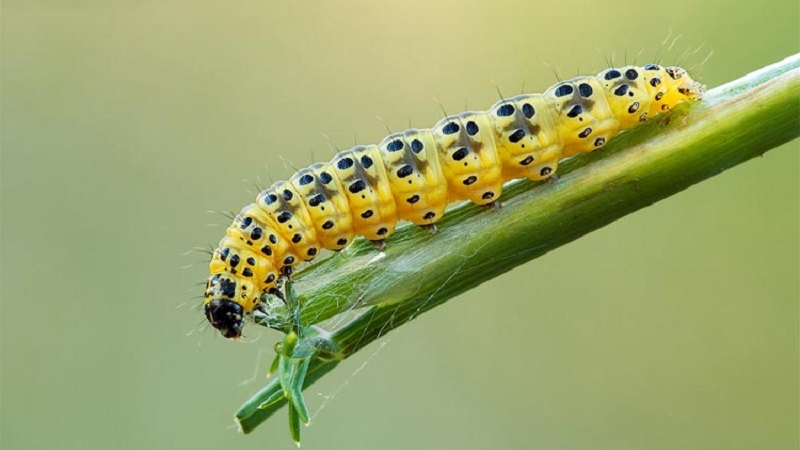
Caterpillars feed on the leaves and fruits of the plant. Some varieties are even able to eat wood and honeysuckle buds.
If the caterpillars have already hit the plant, it will be difficult to get rid of them. Species that eat leaves are eliminated using chemical and folk remedies. It is much more difficult to deal with pests found in fruits. In this case, the affected crop cannot be saved.
How to deal with caterpillars on honeysuckle depends on their species. The characteristic signs will help to recognize the pest.
Sawflies
Caterpillars of the honeysuckle striped sawfly have a thickened body of light green color with yellow stripes. They feed on the leaves of the plant, eating away the tender part and leaving the veins. A large number of pests can leave honeysuckle without leaves.
The mutable sawfly also feeds on the tender part of the leaves. It is a thinner caterpillar with a yellow head and a green body with black specks.
They fight pests in the following ways:
- Insecticides. This is the most effective way to deal with caterpillars. On decorative honeysuckle, it is used at any time, and on a plant with edible berries - only in early spring. Examples of effective remedies: Karbofos, Arrivo.
- Wormwood with soda. 1 kg of wormwood is poured with 10 liters of hot water and infused for 3 days. The infusion is filtered and 100 g of soda is added.
- Coniferous infusion. 2 kg of coniferous needles are cut or twisted in a meat grinder, pour 10 liters of water and insist in a dark place for a week. The entire period of infusion, the mixture is stirred at least 2 times a day. After this time, the infusion is filtered and diluted with warm water in a ratio of 1: 3.
Leaf rollers
Leafworm larvae feed on leaves, as the name of the insect implies. Honeysuckle usually affects 3 types of such a pest:
- Willow crooked. The caterpillar is bright green with a brownish head and two triangular spots on the front shield. It eats fruits and leaves, first braiding them with a cobweb. Rolls the leaves into a tube or ball.
- Herbal leaf roll. Black caterpillars with white spots and a brown head. They fold several leaves into a dense tube, settle inside and eat out large holes in them.
- Various. Gray-green caterpillars with black warts on the chest and brown head settle inside a bundle of leaves.
Many gardeners, when asked what to do if there is a spider web on the honeysuckle, answer that it is necessary to fight the tick. In fact, a leafworm can also braid the leaves with thin fibers.
They fight the pest with the following means:
- Systemic insecticides. They directly poison the leaves of the plant. The most effective against leaf rollers are Actellic and Karbofos.
- A decoction of tomato tops. 4 kg of tomato tops are poured into 10 liters of water and infused for 4 hours. Then 30 min. boil over low heat and let it brew for 24 hours. The broth is filtered, bottled and stored for a month. Just before use, dilute with water in a 1: 1 ratio and add a little soap.
- Wormwood decoction. The bucket is half filled with wormwood, the rest of the volume is added with water. The herb is allowed to brew for 3 days. Then boil for half an hour over low heat. The broth is cooled and filtered. Add water so that the total amount of the mixture reaches 10 liters. Before use, the infusion is diluted in half with water.
Mole
The moth lays the larvae, which feed on the leaves of bush plants.Honeysuckle in the garden is usually attacked by the following types of pests:
- Nondescript. Small burgundy caterpillars feed on the leaves of the plant.
- Baby honeysuckle. Small larvae feed on leaves, leaving characteristic white winding paths.
- Motley. The white-yellow caterpillar feeds on leaves, leaving behind whitish paths.
Regardless of the type of moth, the methods of dealing with it are the same. To get rid of the pest, the shrub is sprayed with "Fufanon" or "Karbofos".
Moth
The pest caterpillar resembles a small twig. It can be brown, green or yellow-green in color. Has developed muscles, when moving strongly arches the body, can stand on the hind limbs for a long time.
It feeds on leaves, gnawing large holes in them. In this case, the veins remain intact. The pest forms spider nests.
To get rid of an insect, it is shaken off or collected by hand. If that doesn't work, use insecticides.
note! Moth infestations can last for several years. When the plant is abundantly populated, the caterpillars eat all the leaves.
Cabbage scoop
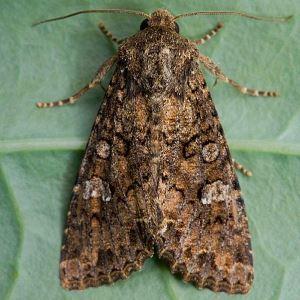
The cabbage scoop affects not only cabbage. It also feeds on fruit and berry bushes. The pest settles in berries, leading to their rotting.
Caterpillars of cabbage scoop are brown or brown in color and many black and dark brown spots, so the insect is invisible on the tree.
To get rid of the pest, use one of the means:
- Pyrethroids. They act selectively and are not addictive. Such drugs as "Decis", "Inta-Vir" are suitable.
- Tobacco, ash and mustard. 15 g of mustard powder are poured into a bucket of water and 1 tbsp. ash and tobacco. Ingredients pour 10 liters of boiling water and leave for 3 days. Then it is filtered and mixed with 40 g of grated soap.
- Spicy pepper. 200 g of hot pepper is finely chopped and boiled for 15 minutes. in 2 liters of water. The broth is infused for 2 days. Then filter and dilute 8 liters of water.
Honeysuckle hawk moth
Honeysuckle bumblebees lay light green larvae with a dark green head and light dots on the body. The pest feeds on young leaves, causing significant damage to the plant.
To combat it, insecticides are used. A decoction of wormwood or an infusion of hot pepper is also suitable.
It is interesting:
How to get rid of spider mites on cucumbers in a greenhouse.
What to do if caterpillars are bred in tomatoes - popular ways to combat a pest.
Beetles
Honeysuckle beetles are no less dangerous than caterpillars. They feed on the bark and leaves of the tree. They often cause plant death.
Zlatka
Zlatka is a dangerous pest of fruit and berry bushes. The bugs have an elongated iridescent green body and a black head. The beetle itself and its larvae cause harm.
Beetles gnaw through the leaves, buds and bark of the bush. The larvae settle in the root system, gnawing through the passages in it and the root collar. Zlatka often causes the death of young honeysuckle.
Note! Goldfish is a shy beetle. At the slightest danger, he falls from a tree to the ground or hides under the bark.
To get rid of the pest, spread a light cloth or film under the bush and shake the plant. The scattered beetles are collected and destroyed. After that, the honeysuckle is sprayed with insecticides.
Barbel honeysuckle
The honeysuckle barbel is a beetle up to 2 cm long with a black back, light brown legs and head. The larvae feed on young shoots. Beetles gnaw at leaves.
Get rid of the pest according to the following scheme:
- Beetles are collected from the bush by hand.
- Drying shoots are removed.
- Honeysuckle is sprayed with "Fufanon".
- "Fufanon" is also poured into the holes in the stems.
Cherry fly
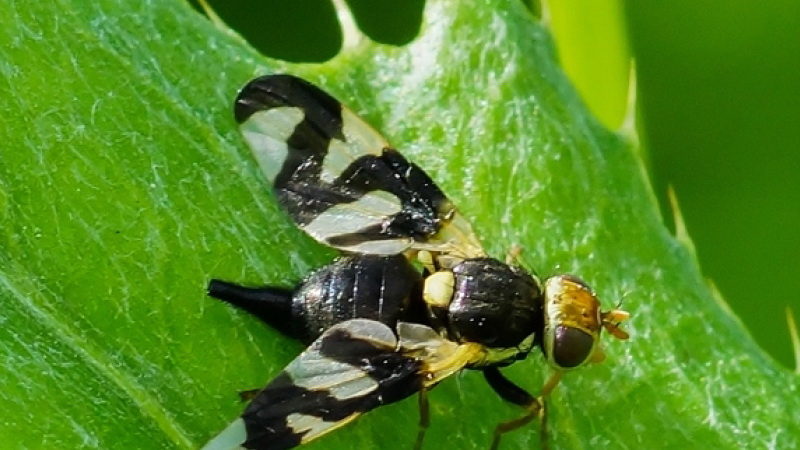
The cherry fly (see photo above) lays small worm-like larvae in the berries on the honeysuckle. They feed on the juice of the fruit, filling them with excrement.
If the larva has already settled in the berries, it will not be possible to get rid of it.To save the crop from the pest, preventive treatments with insecticides are carried out.
Bedbugs
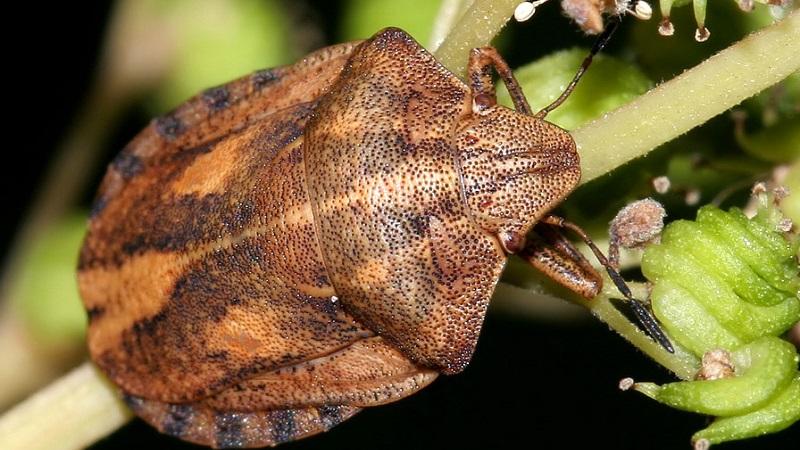
Bed bugs are sucking insects that feed on plant juices. This leads to a gradual wilting and leaf fall on the bush. Bedbugs rarely infect a bush in such numbers as to seriously harm it.
Single beetles are collected by hand. For prevention, the bushes are sprayed with insecticides in early spring.
Note! Bed bugs on honeysuckle berries spoil their taste.
Honeysuckle diseases and their treatment
For honeysuckle, not only pests are dangerous, but also diseases. Fighting them takes much more time. To cure honeysuckle, it is important to correctly identify the disease. To do this, you need to know the main symptoms.
Fungal
Fungal diseases most often affect honeysuckle when the rules of care are violated. Without timely treatment, they quickly destroy the plant. However, if you start the fight on time, in most cases the bush can be saved.
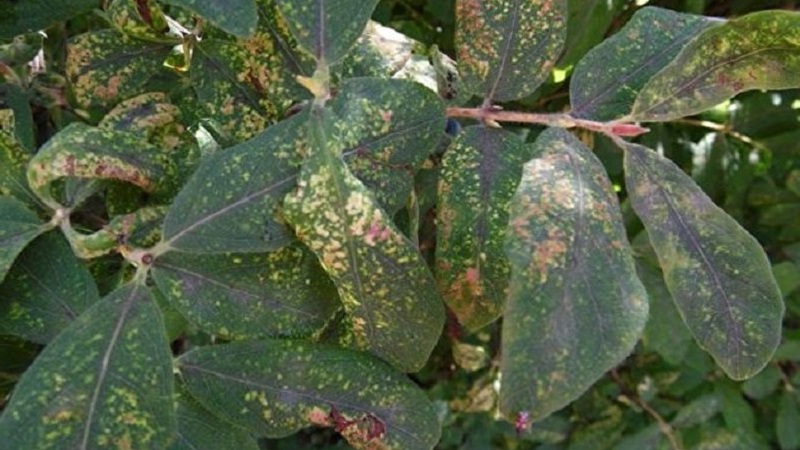
Description of common fungal diseases:
- Powdery mildew... Leaves are covered with white bloom. Later, black dots form on them. This leads to browning and shrinkage. The shoots are deformed and fall off.
- Ascochitous spotting. The leaves are covered with gray irregular spots with a dark border. Black dot formations soon form. This leads to drying out and falling off of the leaf plates.
- Brown spotting. Irregular brown spots with a dark border appear on the leaf blades. They merge and gradually cover all the leaves, causing them to fall off.
- Red-olive blotch. Reddish-gray spots appear along the edges of the leaves. Gradually, they increase in size and cover the entire leaf plate, leading to its falling off.
Fight against fungal diseases with the help of fungicides. All affected parts are removed before processing.
Viral
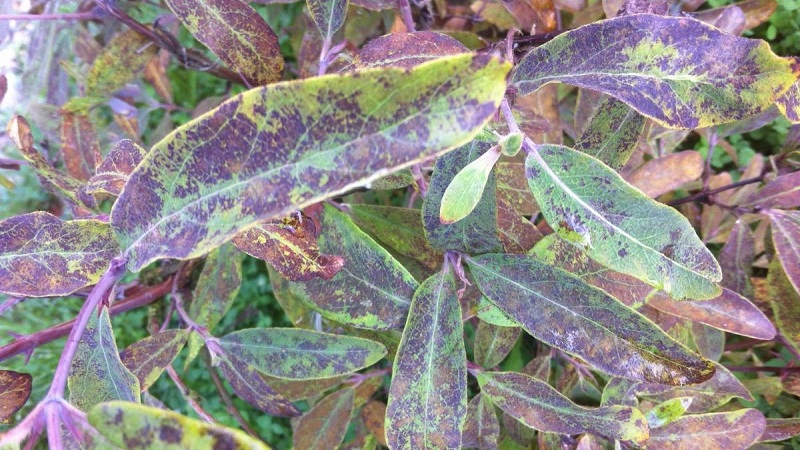
Honeysuckle viral diseases include a mosaic-rezuha. In this disease, the leaf plates are covered with light spots of irregular shape, rounded yellow areas and yellow veins. At the same time, a large number of weak lateral shoots grow. The leaves are underdeveloped and small.
The viral infection is carried by insects and wind. There are no methods to combat it. A diseased plant is dug up and taken away from the site.
How to remove an anthill in the roots of honeysuckle
Ants eat many pests and increase the amount of potassium and phosphorus in the soil. However, they become the main cause of aphids on plants and often eat honeysuckle fruits.
The anthill in the roots of the bush must be eliminated. To do this, use special means, for example, "Diazinon". The drug causes paralysis of the nervous system and the death of insects. Moreover, it is absolutely safe for the plant.
Council. There are also folk methods of fighting ants. One of them is pouring boiling water into the anthill.
What animals harm honeysuckle
The danger for fruit and berry bushes is not only insects, but also animals:
- Hare. Eats bark.
- Mice, hamsters, shrews. They feed on the roots and berries of plants.
- Moles. They do not eat honeysuckle, but they can dig a hole in the roots.
To get rid of harmful animals, scarers are installed. The cat will help to cope with rodents.
It is interesting:
How to deal with potato moth and win.
Why is a cotton scoop on corn dangerous?
How to get rid of mice and rats that gnaw potatoes in the cellar.
Conclusion
Despite the fact that honeysuckle is an unpretentious plant, danger often awaits it in the garden. Shrubs and lianas attack pests, diseases and even animals. They often cause plant death.
In order to save honeysuckle plantings, it is important to regularly examine them for infection and insects and, if the first signs are found, immediately begin treatment.